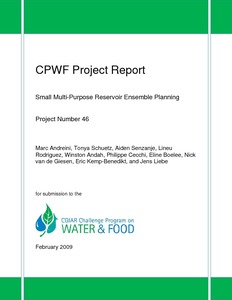Resource information
People living in arid areas with highly variable rainfall, experience droughts and floods and often have insecure livelihoods. Small multi-purpose reservoirs are a widely used form of infrastructure for the provision of water. They supply water for domestic use, livestock watering, small scale irrigation, and other beneficial uses. The reservoirs are hydrologically linked by the streams that have been dammed. Although reservoirs store a large quantity of water and have a significant effect on downstream flows, they have rarely been considered as systems, with synergies and tradeoffs resulting from the number and density of their structures. Often reservoirs were constructed in a series of projects funded by different agencies, at different times, with little or no coordination among the implementing partners. A significant number are functioning sub-optimally and/or are falling into disrepair. This indicates that there is room for improvement in the planning, operation, and maintenance of small reservoirs. The water management institutions in Volta, Limpopo, and Sao Francisco Basins are being revamped to better serve their constituencies. We have an opportunity to collaborate with government officials, stakeholders, and farmers who are actively looking for ways to improve the planning process.
The Small Reservoir Project team developed a tool kit to support the planning, development, and management of small reservoir ensembles on the basin level and the use of small multi-purpose reservoirs that are properly located, well designed, operated and maintained in sustainable fashion, and economically viable on the local/community level. There are tools to improve intervention planning, storage estimation and the analysis of the hydrology, ecology and health of small reservoirs. There ara also tools for the analysis of institutional and economic aspects of the reservoirs. The toolkit not only includes the necessary analytical instruments, but also a set of process oriented tools for improved participatory decision making. The Tool Kit is meant to be a living “document” with additional tools and experiences to be added as they are developed.


